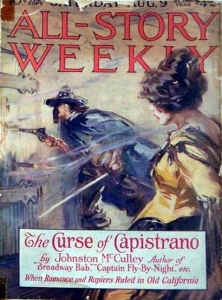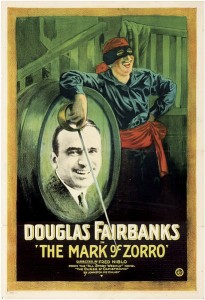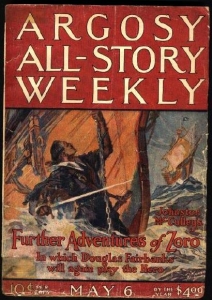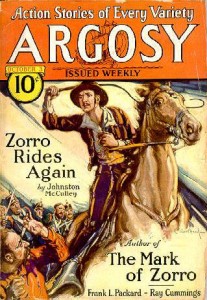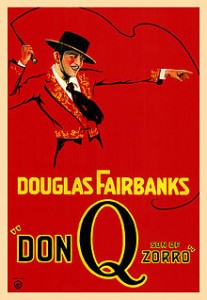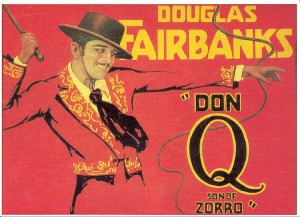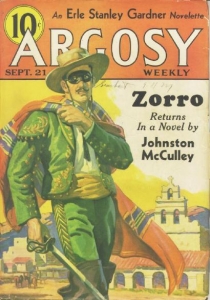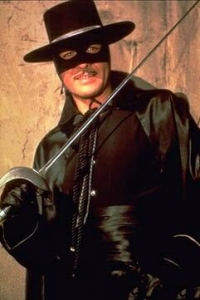Unknown Artist
The Curse of Capistrano, 1919
Cover illustration for “The Curse of Capistrano” by Johnston McCulley in All-Story Weekly (August 9, 1919)
Nearly a hundred years ago the pulp story writer, Johnston McCulley (1883-1958), created the masked character of Zorro, the secret identity of the nobleman, Don Diego de la Vega, who lived during the Spanish colonial period in California. McCulley’s first Zorro story was called “The Curse of Capistrano” and was published serially in the pulp magazine All-Story Weekly. The magazine’s cover for the week of the first installment was the above illustration of this headlined story, created by an unidentified illustrator.
In the background of the illustration, a masked, hated, and caped Zorro with his pistol in his right hand poised to shoot through the hinged door just in front of his pistol’s muzzle. His left hand holds his sword at ready. The barrel and muzzle of his opponent’s rifle poke through the wooden door with the orange-red flare at the muzzle’s tip indicating a bullet has just been shot into the space where Zorro stands. I love the painted smoke that wafts through the space and around the figures. Painting something insubstantial is always a challenge, and smoke appears to take on the coloration of whatever it passes over. Our anonymous illustrator did a very good job of conveying the wafting insubstantial nature of smoke.
This adventure story of the masked outlaw who defends people from tyrannical officials and other villains was a popular hit. While on their honeymoon, Douglas Fairbanks and Mary Pickford chose this story as the inaugural picture for their new studio, United Artists. Their film adaption was released in 1920 as The Mark of Zorro and McCulley’s story was released and then re-released by Grosset and Dunlap under the same title to tie it more closely with the film.
The movie’s poster (see above) shows the Zorro character with a mask over his eyes and a scarf wrapped around his head to further disguise the man within of the character.
Patrick John Monahan (1882-1931) Robert A. Graef (1878-1951)
The Further Adventures of Zorro Zorro Rides Again
Cover illustration for “The Further Cover illustration for “Zorro Rides Again” by Johnston
Adventures of Zorro” by Johnston McCulley in Argosy (October 3, 1931)
McCulley in Argosy All-Story Weekly (May 6, 1922)
It was not until 1922 that a second Zorro story was published, and again the cover of that magazine’s issue had the story-related illustration this time by a known pulp-illustrator, Patrick J. Monahan.* The third Zorro story was published in 1931, again garnering the cover of that magazine’s issue this time painted by Robert A. Graef.** (See above.) It is interesting that the first Zorro magazine cover illustration and the movie poster clearly show the character as masked, while the second and third cover illustrations do not. The second cover by Monahan has Zorro holding his sword in his right hand and the third cover by Graef has Don Diego/Zorro on horseback with a whip in his right hand.
In 1925 United Artists produced a sequel to the first Zorro movie, this one is titled, Don Q, Son of Zorro with Douglas Fairbanks again playing the leading man and also serving as the producer of the movie. The movie was rated one of the top ten movies of 1925 by The New York Times. The theatrical posters promoting this film were
wonders of color and design. But more important for this visual study is that they helped to reinforce the look of the leading character, Zorro. These posters show Don Q with a whip in hand looking like a nobleman with lapels, cuffs, and hem of his short bolero-style jacket decorated with close-worked embroidery. His sombrero cordobés hat is of the style made in Córdoba, Spain and traditionally worn in Andalusia—it is commonly made in black with a high flat crown. Zorro is typically depicted wearing this style of hat. And when he is Zorro, his eyes are masked.
Unknown artist
Zorro Returns
Cover illustration for “Mysterious Don Miguel” by Johnston McCulley in Argosy (September 21, 1935)
There is only one more pulp magazine cover focused on Zorro*** and that was published in Argosy magazine in 1935 and illustrated by an unknown artist. With this illustration we see that the standard for the look of Zorro seems to be set: his eyes are masked; he wears the proper sombrero cordobés; and his suit is the short-jacketed bolero-style with embroidered decoration on the jacket and also the pants.
By the time Disney produced the television version of the story (1957-59) with Guy Williams in the character’s role, the costume was set: a black Spanish-style suit; a flat-brimmed black sombrero cordobés; a black cape or cloak; and a black cloth mask covering from the eyes up over the head. Zorro’s sword is a rapier and he often used a bullwhip. So what we think of when we imagine Zorro (pre Antonio Banderas) is the constructed character as visualized by pulp story writers, illustrators, film directors and producers – all evidence of American popular visual culture.
* Monahan studied art at the Des Moines Academy of Art while he worked at the local newspaper. After moving to New York and continuing his training at the Arts Students League, Monahan was working for various newspapers and magazines and doing pulp magazine illustrations. See, https://www.pulpartists.com/Monahan.html
** Graef was a New Yorker and he studied art at Pratt Institute in Brooklyn and then produced illustrations for all the major magazines. See, https://www.pulpartists.com/Graef.html
*** Out of the over fifty magazine stories published about Zorro and written by Johnston McCulley.
October 3, 2013
By Joyce K. Schiller, Curator, Rockwell Center for American Visual Studies, Norman Rockwell Museum


